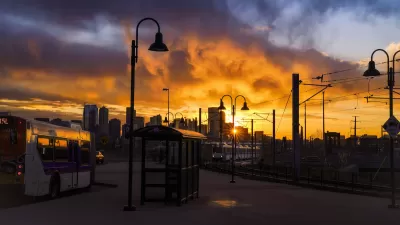The 19 is one of the city's most popular bus routes, but a new plan will reduce wait times and speed up buses with pre-pay, signal priority, bump outs, and other improvements. Also, the 19 bus will become the C Line.
The Twin Cities are in the process of adding bus rapid transit, starting with the A Line in St. Paul, which opened in June 2016 and has since outperformed ridership projections. "Now comes BRT No. 2 — its construction, at least. A ceremonial groundbreaking Tuesday will kick off building of the C Line, which, once completed, will begin at the Brooklyn Center Transit Center and travel down Brooklyn Boulevard, Penn Avenue and Olson Memorial Highway before terminating at Hennepin Healthcare (formerly HCMC)," Peter Callaghan writes. The C Line will increase frequency and speed up trips with suite of improvements.
"The C Line has a $37 million budget and includes the construction of stations and purchase of new buses, including eight electric buses, purchased with a federal grant," Callaghan writes. But, more buses are just part of the plan—these buses should also move more quickly, with bump outs buses won't have to pull in and out of traffic. "Roth said the agency estimates that travel times on the C Line will be 20-25 percent faster than on the current bus line. Faster boarding helps. BRT buses permit exiting and boarding from all doors because tickets are purchased at the station, similar to light rail ticketing," Callaghan reports.
Besides spending less time at stops, buses should spend less time at red lights. "And the buses are equipped with automated signal priority systems that communicate with traffic light controls and might either keep a green light shining longer or get a red to change sooner than it might otherwise," Callaghan reports.
FULL STORY: 'It's a big deal': C Line to bring bus rapid transit to popular north Minneapolis route

Alabama: Trump Terminates Settlements for Black Communities Harmed By Raw Sewage
Trump deemed the landmark civil rights agreement “illegal DEI and environmental justice policy.”

Planetizen Federal Action Tracker
A weekly monitor of how Trump’s orders and actions are impacting planners and planning in America.

Why Should We Subsidize Public Transportation?
Many public transit agencies face financial stress due to rising costs, declining fare revenue, and declining subsidies. Transit advocates must provide a strong business case for increasing public transit funding.

Understanding Road Diets
An explainer from Momentum highlights the advantages of reducing vehicle lanes in favor of more bike, transit, and pedestrian infrastructure.

New California Law Regulates Warehouse Pollution
A new law tightens building and emissions regulations for large distribution warehouses to mitigate air pollution and traffic in surrounding communities.

Phoenix Announces Opening Date for Light Rail Extension
The South Central extension will connect South Phoenix to downtown and other major hubs starting on June 7.
Urban Design for Planners 1: Software Tools
This six-course series explores essential urban design concepts using open source software and equips planners with the tools they need to participate fully in the urban design process.
Planning for Universal Design
Learn the tools for implementing Universal Design in planning regulations.
Caltrans
Smith Gee Studio
Institute for Housing and Urban Development Studies (IHS)
City of Grandview
Harvard GSD Executive Education
Toledo-Lucas County Plan Commissions
Salt Lake City
NYU Wagner Graduate School of Public Service





























